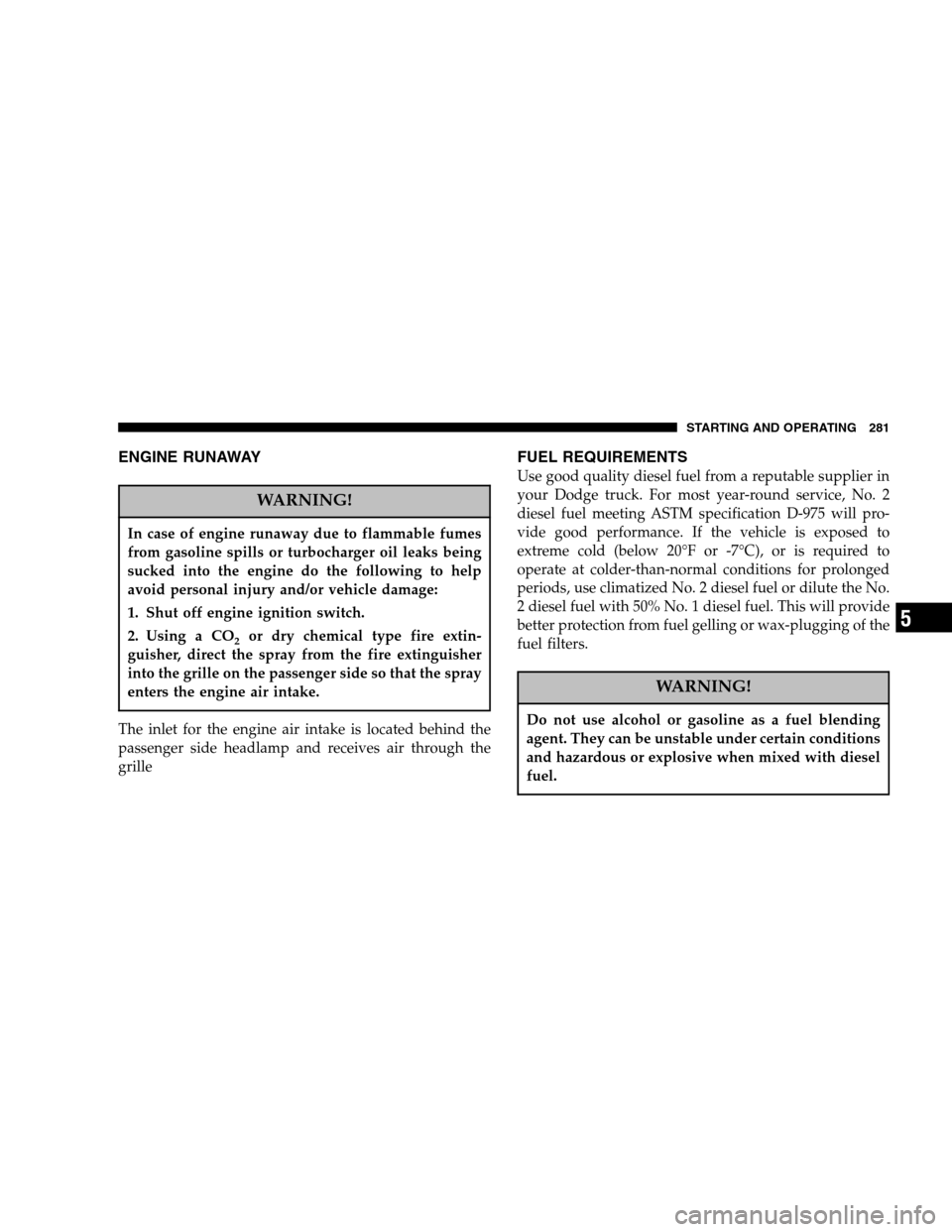Page 281 of 448

ENGINE RUNAWAY
WARNING!
In case of engine runaway due to flammable fumes
from gasoline spills or turbocharger oil leaks being
sucked into the engine do the following to help
avoid personal injury and/or vehicle damage:
1. Shut off engine ignition switch.
2. Using a CO
2or dry chemical type fire extin-
guisher, direct the spray from the fire extinguisher
into the grille on the passenger side so that the spray
enters the engine air intake.
The inlet for the engine air intake is located behind the
passenger side headlamp and receives air through the
grille
FUEL REQUIREMENTS
Use good quality diesel fuel from a reputable supplier in
your Dodge truck. For most year-round service, No. 2
diesel fuel meeting ASTM specification D-975 will pro-
vide good performance. If the vehicle is exposed to
extreme cold (below 20°F or -7°C), or is required to
operate at colder-than-normal conditions for prolonged
periods, use climatized No. 2 diesel fuel or dilute the No.
2 diesel fuel with 50% No. 1 diesel fuel. This will provide
better protection from fuel gelling or wax-plugging of the
fuel filters.
WARNING!
Do not use alcohol or gasoline as a fuel blending
agent. They can be unstable under certain conditions
and hazardous or explosive when mixed with diesel
fuel.
STARTING AND OPERATING 281
5
Page 283 of 448
Fuel Filler Cap (Gas Cap)
The gas cap is behind the fuel filler door. If the gas cap is
lost or damaged, be sure the replacement cap is for use
with this vehicle.
CAUTION!
Damage to the fuel system or emission control
system could result from using an improper fuel
tank filler tube cap (gas cap). A poorly fitting cap
could let impurities into the fuel system.
WARNING!
•Remove the fuel tank filler tube cap (gas cap)
slowly to prevent fuel spray from the filler neck
which may cause injury.
•The volatility of some fuels may cause a buildup
of pressure in the fuel tank that may increase
while you drive. This pressure can result in a
spray of fuel and/or vapors when the cap is
removed from a hot vehicle. Removing the cap
slowly allows the pressure to vent and prevents
fuel spray.
•Never have any smoking materials lit in or near
the vehicle when the gas cap is removed or the
tank filled.
•Never add fuel to the vehicle when the engine is
running.
STARTING AND OPERATING 283
5
Page 284 of 448

Avoid Using Contaminated Fuel
Fuel that is contaminated by water or dirt can cause
severe damage to the engine fuel system. Proper main-
tenance of the engine fuel filter and fuel tank is essential.
(See Section 7 for Maintenance Procedures).
NOTE:Climatized diesel fuel is a blend of Number 2
and Number 1 Diesel fuel which reduces the temperature
at which wax crystals form in the fuel.
Bulk Fuel Storage
If you store quantities of fuel, good maintenance of the
stored fuel is also essential. Fuel contaminated with
water will promote the growth of “microbes.” These
microbes form “slime” that will clog fuel filters and lines.
Drain condensation from the supply tank and change the
line filter on a regular basis.
Fuel Specifications
The Cummins Turbocharged, Charge Air Cooled, Diesel
engine has been developed to take advantage of the high
energy content and generally lower cost No. 2 diesel fuel
or No. 2 climatized diesel fuels. Experience has shown
that it also operates on No. 1 diesel fuels or other fuels
within the specifications in the following chart.
NOTE:A maximum blend of 5% biodiesel may be used
with your Cummins Diesel equipped Dodge Ram Truck.
NOTE:In addition, commercially available fuel addi-
tives are not necessary for the proper operation of your
Cummins Diesel equipped Dodge Ram Truck.
NOTE:No. 1 diesel fuel should only be used where
extended arctic conditions (-10°F or 23°C) exist.
284 STARTING AND OPERATING
Page 290 of 448

CAUTION!
•During the first 500 miles (805 km) your new
vehicle is driven, do not tow a trailer. Doing so
may damage your vehicle.
•When first towing a trailer, limit your speed to 50
mph (80 km/h) during the first 500 miles (805 km)
of towing.
Perform the maintenance listed in the “Maintenance
Schedules” section of this manual (Section 8). When
towing a trailer, never exceed the Gross Axle Weight
Rating (GAWR), or Gross Combined Vehicle Weight
(GCVW).
CAUTION!
When hauling cargo or towing a trailer, do not
overload your vehicle or trailer. Overloading can
cause a loss of control, poor performance or damage
to brakes, axle, engine, transmission, steering, sus-
pension, body structure or tires.
Consider the following items when computing the
weight on the rear axle:
•the tongue weight of the trailer
•the weight of any other type of cargo or equipment put
in or on your vehicle
•the weight of passenger’s and driver
NOTE:Remember that everything put into or on the
trailer adds to the load on your vehicle. Also, additional
factory-installed options, or dealer-installed options,
290 STARTING AND OPERATING
Page 297 of 448
Cooling System Tips — Trailer Towing
To reduce potential for engine and transmission over-
heating, take the following actions in high ambient
temperatures:
•City Driving—when stopped, put the transmission in
N (Neutral) and increase the engine idle speed.
•Highway Driving—reduce your speed.
•Air Conditioning—turn it off temporarily.
•Hilly Terrain—Turn overdrive off.
See Cooling System Operating information in the Service
and Maintenance section of this manual for more infor-
mation.
STARTING AND OPERATING 297
5
Page 298 of 448

Automatic Transmission Oil Temperature Warning
Light
All vehicles with heavy duty transmission oil cooling are
equipped with a transmission sump oil temperature
sensor and warning light. If elevated transmission tem-
peratures are encountered, the engine controller will
select the most desirable gear until the transmission
temperatures are reduced. If transmission oil tempera-
tures continue to rise, a warning light located in the
instrument cluster will illuminate. If this should occur,
stop the vehicle, shift to Neutral, and run the engine at
idle or faster until the light goes off.
Towing With An Automatic Transmission
Vehicles equipped with an automatic transmission may
shift into and out of Overdrive, or a lower gear, when
driving in hilly areas, when heavily loaded, or when
towing into heavy winds.When this condition occurs, press the “TOW/HAUL”
button or shift into a lower gear to prevent excessive
transmission wear and/or overheating, and to provide
better engine braking.
NOTE:Do not exceed the following RPM while manu-
ally downshifting:
•5.9L Diesel Engines 3200 RPM.
If your vehicle has an automatic transmission and you
tow a trailer frequently, change transmission fluid and
filter(s) according to Maintenance Schedule “B.”
SNOWPLOW
Snowplow Prep Packages are available as a factory
installed option. These packages include components
necessary to equip your vehicle with a snowplow.
NOTE:Before installation of a snowplow it is highly
recommended that the owner / installer obtain and
follow the recommendations contained within the Dodge
298 STARTING AND OPERATING
Page 300 of 448

2. The total GVWR or the Front GAWR or the Rear
GAWR should never be exceeded.
3. The snowplow prep packages are not available with
the Sport Package.
4. Cargo capacity will be reduced by the addition of
options or passengers, etc.
The loaded vehicle weight, including the snowplow
system, all aftermarket accessories, driver, passengers,
options, and cargo, must not exceed either the Gross
Vehicle Weight (GVWR) or Gross Axle Weight (GAWR)
ratings. These weights are specified on the Safety Com-
pliance Certification Label on the driver’s side door
opening.
NOTE:Detach the snowplow when transporting pas-
sengers.
Vehicle front end wheel alignment was set to specifica-
tions at the factory without consideration for the weightof the plow. Front end tow-in should be checked and
reset if necessary at the beginning and end of the
snowplow season. This will help prevent uneven tire
wear.
The blade should be lowered whenever the vehicle is
parked.
Maintain and operate your vehicle and snowplow equip-
ment following the recommendations provided by the
specific snowplow manufacturer.
Over the Road Operation With Snowplow
Attached
The blade restricts air flow to the radiator and causes the
engine to operate at higher than normal temperatures.
Therefore, when transporting the plow, angle the blade
completely and position it as low as road or surface
conditions permit. Do not exceed 40 mph (64 km/h). The
operator should always maintain a safe stopping distance
and allow adequate passing clearance.
300 STARTING AND OPERATING
Page 302 of 448
•Operate with transfer case in 4L when plowing small
or congested areas where speeds are not likely to
exceed 15 mph (24 km/h). At higher speeds operate in
4H.
•Vehicles with 48RE transmissions should use 4L range
when plowing deep or heavy snow for extended
periods of time to avoid transmission overheating.
•Do not shift the transmission unless the engine has
returned to idle and wheels have stopped. Make a
practice of stepping on the brake pedal before shifting
the transmission.
RECREATIONAL TOWING — 4 WHEEL DRIVE
VEHICLES (BEHIND MOTORHOME, ETC.)
Recreational Towing – 2 Wheel Drive Models
Recreational towing 2 Wheel Drive is not allowed.
Towing with the rear wheels on the ground can result in
severe transmission damage.
CAUTION!
Failure to follow these requirements can cause se-
vere damage to the transmission and/or transfer case.
302 STARTING AND OPERATING